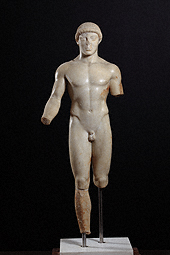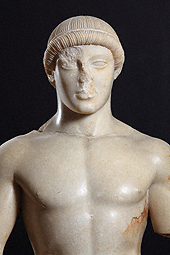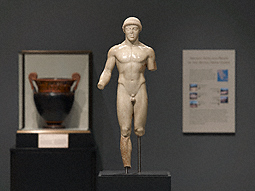| Exhibitions | ||
| Collection | ||
| Education | ||
| Research and Conservation | ||
| Publications | ||
| Games | ||
| Public Programs | ||
| About the J. Paul Getty Museum | ||
| Museum Home
|
October 27, 2010–April 18, 2011 at the Getty Villa
The Agrigento Youth, an important work from the Museo Archeologico Regionale in Agrigento, Sicily, is on loan to the Getty Museum and will be on view through April 19, 2011. The statue is displayed in a gallery devoted to images of Athletes and Competition (Gallery 211) at the Getty Villa. The figure is a rare example of an early classical marble statue called a kouros, or nude young man. |
||||||
The figure was carved by an unknown artist around 480 B.C., at a time of change in artistic styles between the Archaic and the Classical periods when the rigid poses and serene expressions of Archaic works were becoming more naturalistic. Its solemn facial features and erect stance embody the so-called Severe Style. |
||||||
Seismic Protection Before installing the Agrigento Youth at the Getty Villa, the Museum's conservation team collaborated with conservators from Agrigento's Museo Archeologico Regionale to construct a custom seismic isolation base and pedestal. |
||||||
|
About the Museo Archeologico Regionale of Agrigento Located just outside the town at Contrada San Nicola, the Museo Archeologico Regionale in Agrigento, Sicily, chronicles the history of the ancient Greek colony of Akragas and its territory from prehistory to the Roman period. The museum features panoramic views over the Valley of the Temples, designated as a UNESCO World Heritage Site in 1997. The area surrounding the museum was recently identified as the upper part of the ancient city, where numerous architectural remains of an amphitheater and residential quarters have been uncovered. |
||||||
|
The loan of The Agrigento Youth is part of a long-term collaborative agreement between the Getty Museum and the Sicilian Ministry of Culture and Sicilian Identity. Learn more about this cultural collaboration. |
||||||
|
||||||||||||||||||||||||||||



